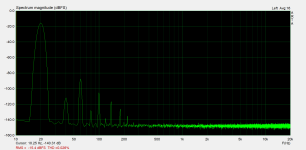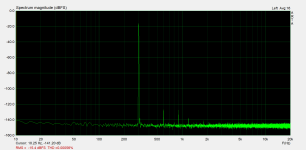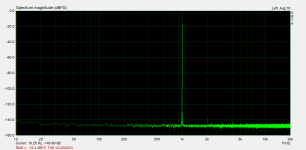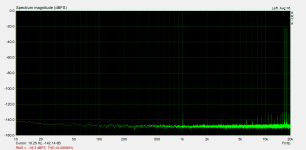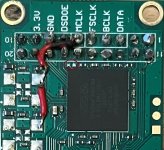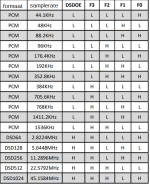Thanks for reacting. I did both.
Switching to slave mode does not work. Via the Amanero configuration tool I get "Audio device not found" while windows perfectly recognizes the driver. I know that the Amanero is properly working (did so with the 2.6.2). I observed Barrows posting also about this, nobody could help.
And I use your pure firmware ofcourse. But J9/Pin28 does not work at all. It just stays low (or high with the 4k7 connected and then you can play nothing at all).
Switching to slave mode does not work. Via the Amanero configuration tool I get "Audio device not found" while windows perfectly recognizes the driver. I know that the Amanero is properly working (did so with the 2.6.2). I observed Barrows posting also about this, nobody could help.
And I use your pure firmware ofcourse. But J9/Pin28 does not work at all. It just stays low (or high with the 4k7 connected and then you can play nothing at all).
I am able to set slave mode according to the instructions with firmware 1096c and 2002b. With other firmware “audio device not found”. But with 1096c it does not work with native dsd only dop. Cannot get it running under windows.
Should I use CLPD for 1080 or slave for 1080. Instructions don’t mention this.
Should I use CLPD for 1080 or slave for 1080. Instructions don’t mention this.
Ok, I found the solution. Very happy!
For this new pure DSD DAC the Amanero should be flashed like this:

And then the Configuration bits like this:

The difference with the instruction from Pavel is small, no DSD Channels SWAP. This is because the channels are already swapped on the circuit/PCB design.
For this new pure DSD DAC the Amanero should be flashed like this:
And then the Configuration bits like this:
The difference with the instruction from Pavel is small, no DSD Channels SWAP. This is because the channels are already swapped on the circuit/PCB design.
Yes, indeed, in the latest versions of Pure, I removed the mute functionality via 28 pin. I just forgot that it is used in some of my own hardware projects. In the next few days I will adjust the firmware for this pin to work.I am still not satisfied with the mute function of the beaglebone.
With my Anubis pro I performed some measurements. The DAC as well as the Joyin Audio T1 trafo's perform excellent. What you see is DSD256 with AMSDMEC 512+fs modulator at 20 Hz, 300 Hz, 1 kHz and 17+18 kHz. HQPlayer volume was set at -6.5dBFS. The waveform at -3dBFS and 24b/44.1kHz. So input level for the DSC2 DAC at -9.5dBFS. There is a bit of trafo loss because of impedance mismatch between the trafo and Anubis input. Normally it should be terminated with a total impedance of 7k (load impedance // amp input impedance). But the loss is mainly due to the fact that the Anubis measures the level at true XLR level while the DSC2 outputs XLR at two times half RCA level.
Attachments
Last edited:
Do you know that U30 is not fully compatible with Amanero? There is no 44/48 switch on this board
To emulate this signal, you can use this scheme.

And I see an error in your photo for switching the U30 to slave mode. You have not removed the resistor in the mckl circuit.
To emulate this signal, you can use this scheme.
And I see an error in your photo for switching the U30 to slave mode. You have not removed the resistor in the mckl circuit.
With respect to the OR gate that you create with the two diodes and resistor, I do not understand how that is going to work. There will be no distinction between 44.1 and 48. This only works nicely in PCM mode. When in DSD mode, DSDOE will be always high and thus will enable only the 45.1584MHz clock. And in DSD mode, F0 only changes with DSD rate, so high for DSD64,256,1024 and low for DSD128,512. But that is irrelevant because with DSDOE always high the output of the OR gate will be always high and enable 45.1584MHz.
Attachments
Cool! Any difference in audio quality observed compared to Beaglebone?Well, removing the resistor works perfectly! The Xing U30 is now also singing!
I use U30 for both PCM and DSD. Therefore, switching with PCM is important to me. My home DSC2 has DSD'it installed.With respect to the OR gate that you create with the two diodes and resistor, I do not understand how that is going to work. There will be no distinction between 44.1 and 48. This only works nicely in PCM mode. When in DSD mode, DSDOE will be always high and thus will enable only the 45.1584MHz clock. And in DSD mode, F0 only changes with DSD rate, so high for DSD64,256,1024 and low for DSD128,512. But that is irrelevant because with DSDOE always high the output of the OR gate will be always high and enable 45.1584MHz.
Agree that this OR scheme fully provides the logic of work according to your table. The DSD format in frequency domain 48 is not standard and is extremely rare.
Last edited:
Ok, thanks for clarification where you come from. So when you use HQPlayer as a source, U30 will not be able to switch to the 49.152MHz clock. HQPlayer should not be enabled to use 48k DSD. And when using primarily the U30 in DSD mode with HQPlayer or other DSD sources, people would not have to install this clock.

In the meantime I found out that the U30 sounds different with respect to the BBG. Seems to be a bit more clear, snappy, involving. But the final verdict has not been set yet.Cool! Any difference in audio quality observed compared to Beaglebone?
Ok, pin28 works indeed!
With regard to sound quality, with 48k range source the beaglebone with 49.152MHz clock is very close to the Xing U30 when the same source is upsampled to DSD with the 45.1584MHz clock.
If the source is in the 44.1k range then the Xing U30 beats the beaglebone in sound quality. So I am thinking of a manual switch to be able to use the Xing U30 in the 48k range, for this specific source material. I have quite some 24b/96kHz music files.
With regard to sound quality, with 48k range source the beaglebone with 49.152MHz clock is very close to the Xing U30 when the same source is upsampled to DSD with the 45.1584MHz clock.
If the source is in the 44.1k range then the Xing U30 beats the beaglebone in sound quality. So I am thinking of a manual switch to be able to use the Xing U30 in the 48k range, for this specific source material. I have quite some 24b/96kHz music files.
- Home
- Source & Line
- Digital Line Level
- Signalyst DSC1
